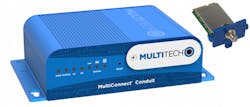Download the PDF version of this article.
The LoRa Alliance’s LoRaWAN (Long Range Wide Area Network) is a Low Power Wide Area Network (LPWAN) made for the Internet of Things (IoT). It is designed for long-range, low-power operation with sensors and controls that work off of batteries or energy-harvesting devices. It has applications in transportation and logistics, smart buildings, smart cities, and agriculture. For example, Vinduino is an open-source, LoRaWAN-based solution for wineries that want to track the soil moisture in their vineyards. It also incorporates an Arduino board and is programmed using Python. LoRa was originally developed by Semtech.
The recent LoRa conference in Philadelphia was host to gateway and hardware vendors as well as service providers like Comcast that announced its machineQ LoRa service. It was able to cover most of the city with only three gateways.
LoRa’s two-key encryption security system works well for multi-tenant services like machineQ. One key is used to encrypt and authenticate exchanges with the network infrastructure. The other is for communication with the data service. This allows Comcast to have access to the infrastructure communication, but not the application data that is encrypted using the other key.
LoRa is not a speed demon. Even at short range it tops out at 50 kbits/s. It scales down to 292 bits/s but with a range that is measured in kilometers as well as being able to penetrate barriers like walls that would stop or significantly attenuate other wireless protocols like Wi-Fi or cellular. This makes LoRa a good choice in buildings or for in-ground sensors like PNI Sensors’ PlacePod magnetic sensor for parking space management that is embedded in the floor.
LoRa gateways like Multi-Tech Systems’ Linux-based, MultiConnect Conduit work with any LoRa device. The gateway actually has a pair of mCard slots and there is an mCard that supports LoRa. Multi-Tech’s mDot modules come in a number of plug-in and solderable form factors.
Multi-Tech Systems’ MultiConnect Conduit supports a pair of plug-in modules such as a LoRa wireless module.
The Sodaq ExpLoRer is an example of a typical LoRa device development platform. It is based on Microchip’s RN2903 LoRa transceiver module and the board also hosts the SAMD21 ARM Cortex-M0 microcontroller. The board has a PCB antenna, Bluetooth 4.2 support and a temperature sensor.
The Sodaq ExpLoRer combines Microchip’s RN2903 LoRa transceiver module with its SAMD21 Arm Cortex-M0 microcontroller.
LoRa uses unlicensed spectrum. The bands differ by country but in North America it uses the 915 Mhz band providing 64 upstream and eight downstream channels. Chirped-FM modulation and high receiver sensitivity help with reception over long distances or through materials. LoRa has broadcast-based firmware over-the-air (FOTA) update support that is slow, because of the network’s speed, but reliable because multiple, RAID-like packets are sent with sufficient redundancy that dropping some will still result in a successful update.
Software overhead on the device and gateway is minimal because of how the protocol works. There is no mesh networking and devices simply transmit and receive packets. Multiple gateways can provide overlapping coverage and they simply forward packets, along with meta information, to a LoRa server. A server is responsible for handling any redundancy. For example, it may receive the same packet from a device through two gateways. The server will discard one and send any response through the best gateway based on the meta data that includes details like the strength of the connection.
LoRa Server is an open-source implementation that handles deduplication. It supports ABP (activation by personalization) and OTAA (over-the-air activation).
Anyone can set up one or more LoRa gateways. Service providers like Comcast allow companies to deploy devices without having to build a WAN infrastructure. Typically end users will have their own gateway for applications like agriculture where service provider coverage is not available.
LoRa has garnered quite a bit of support that is reflected in the number of gateways available as well as the number of modules and chips supporting developers. Users and vendors have a number of options like self-hosting and services like Comcast’s machineQ to choose from. The Things Network is an organization that ties LoRa gateways together that devices can share for free.
LoRa fills a gap between LANs like Bluetooth, Zigbee, and Wi-Fi and wide area networks like cellular. The latter requires the use of a service provider and the coverage is not adjustable by the user eliminating it as an option for some applications.



